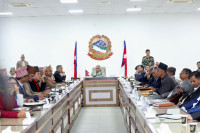National
Administrative costs of international NGOs cross the threshold set by Social Welfare Council
As foreign organisations find it challenging to keep admin cost below 20 percent, there is no legal provision to penalise them..jpg&w=900&height=601)
Prithvi Man Shrestha
Kidasha, a UK-based international non-government organisation, has been implementing a project to mainstream the children from excluded and poor families in four districts since 2015.
The project—Improving the health, learning, and wellbeing of excluded children and families enabling them to benefit from mainstream services and progressively move out of the intergenerational cycle of poverty’—implemented in Kaski, Rupandehi, Kapilvastu and Dhading districts, is found to have done a lot of good works for the excluded children as per an evaluation report prepared by independent auditors appointed by the Social Welfare Council.
But the report presented to the Social Welfare Council, the body regulating both domestic and international non-governmental organisations in the country, in May, also pointed out that its administrative expenditure went well above that set in the Project Agreement Appraisal Guidelines signed between the council and the INGO in the first two years of the five-year programme ending in July 2020.
As per the guidelines, the administrative cost such as expenses for staff salary, stationery, transportation and logistics, should not exceed 20 percent of the total project cost.
But the evaluation report found that the administrative cost in the fiscal year 2015-16 stood at 14 percent, which rose to 21 percent in the fiscal 2016-17 and 26 percent in 2017-18. The project spent a total of Rs69.64 million, Rs32.83 million and Rs26.37 million every year since the fiscal 2015-16.
An INGO cannot run their programme without signing the project agreement. So they keep such cost below 20 percent when they seek approval from the council to run the programme.
However, Kidasha has rejected the findings of the report. Hitman Gurung, programme support manager at Kadisha, claimed that they have maintained the administrative cost below 20 percent. “The calculation made by the evaluation team is mistaken. We have already sent our explanation to the Council regarding the matter.”
On this evaluation report, there had been a discussion at the council on June 26 and the explanation was submitted to the council a week after that meeting, according to Gurung.
It is not the only INGO whose administrative cost went above the maximum threshold. Another evaluation of the Mechi Eye Care Programme with support from the Dutch INGO Eye Care Foundation found that the proportion of administrative cost crossed 20 percent in two of the five years. The five-year programme launched in June 2014 at Mechi Eye Hosptial witnessed an administrative cost as high as 23 percent of the total budget in the third year and 27 percent in the fifth year.
Of the Rs767.23 million budget, the donor agency had intended to spend about 11 percent of total budget on administrative purposes, according to the evaluation report presented to the Council in July this year.
The programme aimed to eliminate the avoidable blindness in Mechi zone with the objective to assist in, and supplement, the national overall target in eye health care by reducing the present prevalence of Blindness in this Zone. Despite a number of INGOs failing to meet the criteria regarding administrative costs, the council does not have legal teeth to take tough action against such organisations.
“There is no legal provision of imposing a penalty on the INGOs that spend more than the threshold in administrative purposes,” said Durga Prasad Bhattarai, information officer at the Council. “We have no alternative other than issuing a letter about their failure to control the administrative expenditure.”
He said that the council has not mulled any strong measure yet although there is a need for taking certain measure to discourage such tendency.
INGOs, on the other hand, claim that maintaining the administrative cost below 20 percent has been challenging for them.
“I have heard that some INGOs have spent the funds received separately from the headquarters to keep the administrative cost within the threshold instead of spending from the budget allocated for the programme,” said Achyut Luitel, chairperson of the Association of International NGOs in Nepal, an information network of INGOs working in Nepal.
He said that keeping a uniform 20 percent administrative cost threshold was not practical. “Better would have been to keep a relatively higher threshold for the programmes run in remote areas and low threshold for the programmes operated in accessible areas,” said Luitel.
According to him, the administrative expenditure of some INGOs has risen due to mobilisation of their own human resources in large numbers of instead of depending on their local partners.
NGOs, on the other hand, feel that the administrative cost shown by the INGOs might be misleading. “Some INGOs categorise the administrative cost of partner NGOs as programme cost,” said Jitram Lama, president of the NGO Federation Nepal, a grouping of NGOs.




 16.12°C Kathmandu
16.12°C Kathmandu




.jpg&w=200&height=120)










